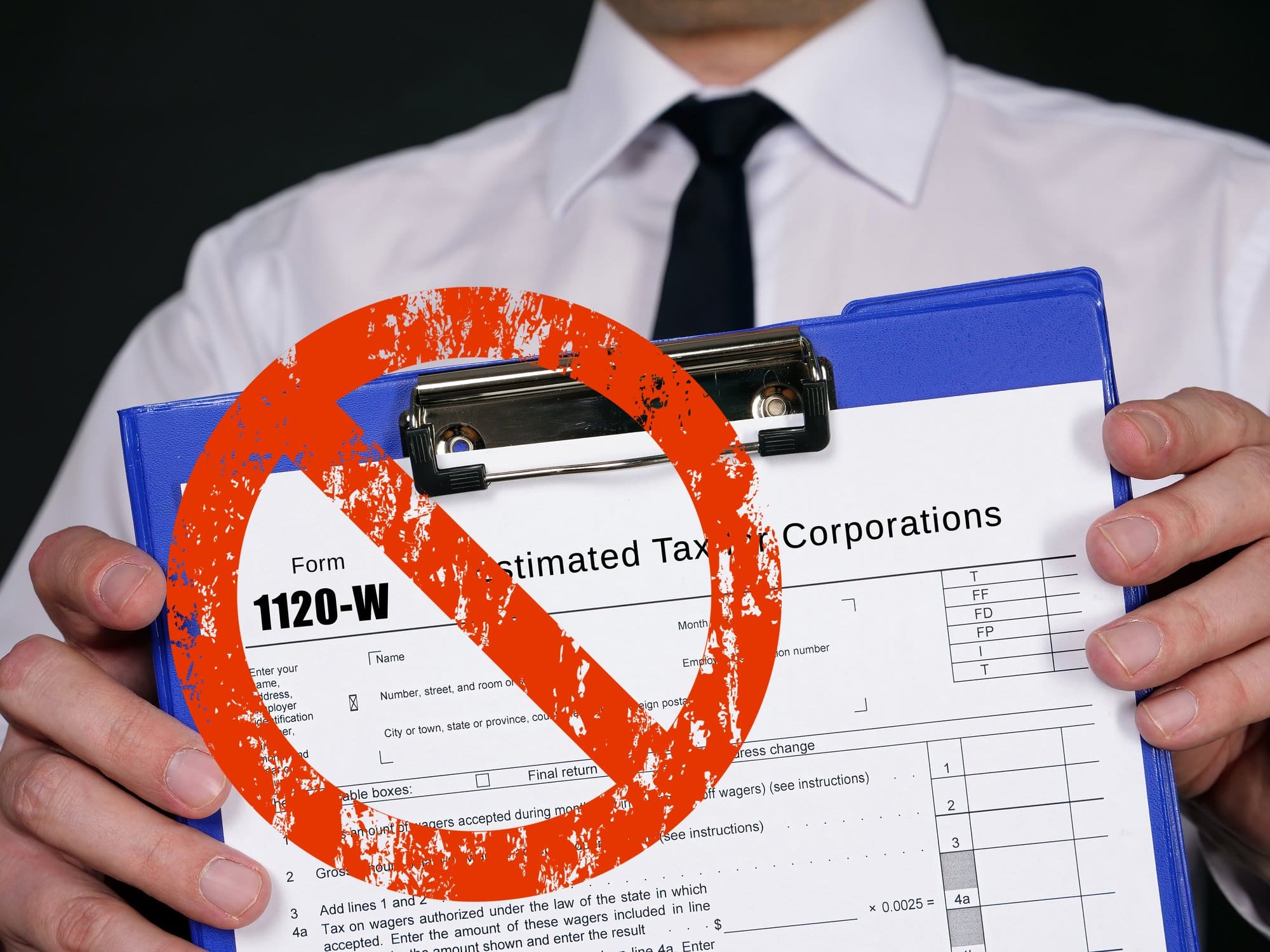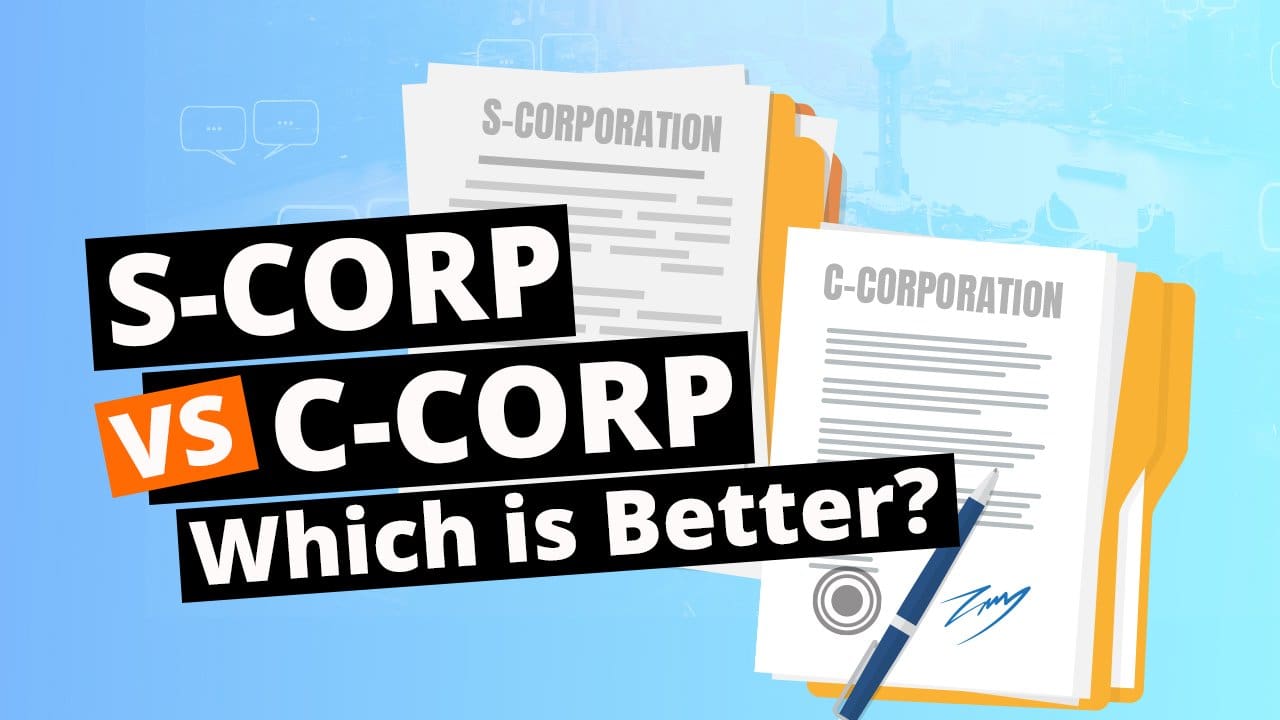Are you considering starting a corporation?
If you want to sell company stock, you’ll have to start a corporation. Most people think about C-Corporations when they think about stocks, but you can also sell stock as an S-Corporation. So, when should you choose an S-Corp vs a C-Corp?
An S-Corp is actually the 2nd most common type of business behind a Limited Liability Company. There’s a good reason for it too! We’ll share why S-Corps are so popular as we discuss the similarities and differences between an S-Corp and C-Corp.
By the time you are done reading this, you’ll know whether you want to start an S-Corp or a C-Corp. The decision comes down to three main considerations:
- Tax consequences
- Type of shareholder
- Your goals
Let’s start by looking at the defining characteristics of a corporation.
What is a corporation?
A corporation is a legal entity that protects the owners from personal liability. The owners are shareholders and are able to sell stock. Corporations have a legal obligation to increase the economic value for their shareholders and are required to file articles of incorporation.
Let’s look at the different kinds of corporations, starting with the C-Corp.
C-Corporation Definition
The C-Corp is the corporation that most of us think about because they are the ones on the stock market. A C-Corp has these defining characteristics:
- Created by filing articles of incorporation.
- Double taxation (taxes charged on both corporate and personal income).
- Limited liability.
- Unlimited shareholders.
- Personal liability protection.
- Must abide by state and federal laws.
- Files under Internal Revenue Code Subchapter C.
- Best if you intend to have an Initial Public Offering (IPO).
Let’s look at an S-Corp next.
S-Corporation Definition
An S-Corporation is similar to a C-Corp but has some substantial differences. The following bullet points list the defining characteristics of an S-Corp:
- Requires the business to be an LLC or a corporation.
- Created by filing a Form 2553 with the IRS to opt to be treated as an S-Corp.
- Limited liability.
- Maximum of 100 shareholders.
- Shareholders must be U.S residents or select business entities.
- Must abide by state and federal laws.
- Must pay owners that are actively involved in the business a reasonable salary.
- Profits are paid as dividends.
- Losses are pass-through income.
- Files under Internal Revenue Code Subchapter S.
- Best if you have less than 100 owners and more than $100,000 net income.
An S-Corp effectively creates a mix between a C-Corp and an LLC when it comes to the tax benefits. It’s not as easy as an LLC’s pass-through income, but not as complicated as a C-Corp.
Other Types of Corporations
Non-profit organizations and Benefit Corporations are also considered corporations. You can learn more about them in our blog about types of business structures.
S-Corp vs C-Corp Similarities

An S-Corp and C-Corp are similar in five primary ways.
- Both are considered separate legal entities.
- Both have the same incorporation documents (unless the S-Corp is filed as an LLC).
- Both an S-Corporation and C-Corporation follow the same state laws.
- Both have a board of directors, shareholders, and a management team.
- Both provide limited liability protection.
- Both pay payroll taxes.
Let’s discuss each of these in more detail.
C-Corporation vs S-Corporation: Legal Entity Status
S-Corporations and C-Corporations are considered legal business entities. This means that the business is a separate entity from the owner(s). This protects the owners if the C-Corp or S-Corp breaks the law, as long as the owner was not directly involved in the law-breaking.
The separate entity status also protects the C-or-S-Corporation from liability if one of the business owners breaks the law when they are not involved in corporate activities. This is the basis for the next section, legal liability protection.
C vs S-Corporation: Limited Liability Protection
Either an S-Corp or C-Corp will separate the business and personal liability in the case of lawsuits or criminal activity. This works in two ways.
- If the business breaks the law and the individual was not involved, there is no personal liability, meaning an employee or customer can’t file a lawsuit against you for something the company did.
- If a business owner is in a lawsuit, the corporation cannot be held liable unless the business owner was actively using company assets to break the law.
This protects wealth for both the owners and the corporation. This is the primary reason why people encourage LLCs, S-Corporations, and C-Corporations over Sole Proprietorships. Check out our blog Sole Proprietorship vs LLC to learn more about why liability protection is so important.
You can learn more about Sole Proprietor vs. LLC vs. S Corporation vs. C Corporation here:
C-Corp vs S-Corp: What Filing Documents Do I Need?
To become a C-Corporation, you will need to file with the Secretary of State where you wish to be incorporated. To find the appropriate secretary of State Office, go to USA.gov.
You’ll need to have the following documents prepared:
- Certificate of Incorporation or Articles of Incorporation
- Organizational Minutes and bylaws
- Shareholder Agreement
- Share Certificate for each shareholder
- IRS Form SS4 – Application for Employer Identification Number
Then you’ll pay a fee that can range from $35 to $300 depending on your state. Each state may have other fees associated with becoming a corporation such as registering a name, sales permits, and other business licenses.
That’s all you have to do to become a C-Corporation. If you want to be a C-Corp filing as an S-Corp, you’ll need to print out Form 2553. You can find the form and instructions on the IRS page about S-Corps.
You’ll need to fill it out and have all shareholders and at least one officer sign and date the form. After every shareholder signs the form, use the table below to find where to send it. This list is also on the form itself.
You can elect S-Corporation status for an LLC as well. To do so, you’ll need to fill out form 2553 after becoming an LLC.

S-Corporation vs C-Corporation: Both Follow State Laws
Because an S-Corporation is a tax classification, both C-Corporations and S-Corporations will be governed by the same state laws. The company is obligated to follow the laws in all states where it has a substantial presence. Cornell Law School provides links to the laws of each state regarding corporations.
If the S-Corp is an LLC, it will need to observe the laws governing LLCs, which can vary from state to state. View laws on LLCs for each state.
Governing Structures are the Same for Both
Both an S-Corp and C-Corp need to have the same governing structures. Most operate with three tiers:
- Stockholders: The number of people who hold shares in the company. They get to vote on important changes like dividends increases, dividend decreases, board of directors, and new executives.
- Board of Directors: Typically shareholders or experts in their field that advise the executive team. The person in charge of leading the meetings is called the Chairman (or Chairperson) of the Board. The Chairman is often the CEO or independent from the management team.
- The Executive Team: Made up of the people in charge of actively running the company. The executive team will typically include the CEO, COO, CFO, CIO, and an attorney.
Some states, like California, have laws dictating how the Board of Directors is structured. California allows either fixed or flexible board sizes. California requires:
- Fixed Board Sizes: May be specified or follow the defaults based on the number of shareholders:
- 1 Shareholder: 1 Director minimum
- 2 Shareholders: 2 Directors minimum
- 3+ Shareholders: 3 Directors minimum
- Flexible Board Sizes: Must follow the rule 2X – 1, where X = minimum based on fixed board sizes.
The information about California is a summary of a more in-depth blog by Tagre Law.
You can see how the rule impacts the number of board members below.

Cautionary Tale: Don’t Make Employees the Chairperson of the Board
I know a person who was the CEO of a company. One of the people who reported to him as an employee was also the Chairperson of the Board, which created a lot of internal conflict in the upper levels of the company.
Long story short, it effectively made it where the two had to agree or nothing got accomplished. Don’t put your company in a position where one opposing view can overrule the CEO’s authority. It becomes a power grab.
C-Corps and S-Corps both pay payroll taxes
Unlike other business structures, S-Corps and C-Corps will have to pay payroll taxes even if the business owners are the only employees. Any corporation will pay tax on 7.65% of employee wages.
S-Corps and C-Corps will also have to collect another 7.65% from the employees’ wages to send to the IRS. These taxes are for Social Security and Medicaid.
The business is also responsible for withdrawing the personal income taxes from all employees’ wages and sending the money to the IRS.
What is the Difference Between C-Corp and S-Corp?

There are four main differences between an S-Corp and a C-Corp:
- Taxation
- Ownership limitations
- Number of shareholders
- The goals of the organization
What is the Taxation Difference Between S-Corp and C-Corp?
The most notable difference between an S-Corp and C-Corp is the tax treatment. Both must file corporate tax returns and pay payroll taxes, but C-Corps have to pay a corporate tax.
There are both corporate income tax implications and personal income tax considerations that should be discussed. This is why running a C-Corporation is considered double taxation.
C-Corporations Have Corporate Income Tax
The federal government taxes C-Corporations for both their employees’ personal income tax and corporate profits. That means business owners have to file both corporate tax returns and personal income tax returns.
This is known as double taxation because the corporate income taxes are 21% of the profits of the company. Then if the profits are paid to the owners as dividends, they will be paying another 15-20% on the dividends.
Double taxation makes it where the federal income tax on the profits can be as high as 41% combined with the dividend payments. This is why publicly held companies either perform buybacks or amass huge piles of cash.
A corporate tax return is filed with the Form 1120 for a C-Corporation or 1120S if they have S-Corporation status. In addition, C-Corporations and corporations electing S-Corp Status have to file quarterly Form 1120W estimates of taxable income for federal tax purposes.
That seems undesirable. Want to know how to avoid that and not pay taxes twice?
S-Corp Status Uses Personal Income Tax Returns

Good news! LLCs with S-Corp status don’t have to file the 1120W like S-Corporations. Nor do S-Corporations pay 21% corporate taxes like C-Corporations.
S-Corporations still have to file an annual corporate tax return using Form 1120S to make sure owners aren’t cheating on taxes. The business owners receive up to three types of income, which they’ll need to claim on the personal tax returns:
- Employee Income: If business owners are actively involved in a company that receives S-Corp status, the business owners must receive a reasonable salary and pay taxes at the personal income tax rates. The salary should be comparable to the median wage for the position.
- Dividend Taxes: All profits will be paid as dividends to the business owners and taxed based on the dividend tax rates which are 0%, 15%, and 20%. The limits for the brackets are far above the tax brackets for the standard personal income tax rate.
- Pass-Though Income: Losses are pass-through income. If after paying reasonable salaries, the business loses money you can use the Qualified Business Income Deduction to claim 20% of your expenses as losses from your personal income tax.
So who wins between S-Corp vs C-Corp tax advantages?
S-Corps are far superior to C-Corps based on the pass-through taxation rules as long as the small business corporation does not have more than 100 members.
S-Corps Have Limitations on Shareholders
An S-Corp has a lot of restrictions on who can be a small business owner that C-Corps do not. The S-Corps shareholder restrictions include:
- No foreign entities or people.
- Only U.S residents, certain trusts, and estates can own shares.
- No partnerships or corporations can own shares.
- Cannot have multiple classes of shares, for instance, voting and non-voting shares.
- Financial institutions, insurance companies, and domestic international sales corporations cannot be shareholders of S-Corps shares.
This small business entity is different from many others in this regard. If you choose this corporation tax status, you’ll have to change it if you want to offer more than one class of stock or allow a restricted shareholder.
Changing the filing status may not be an easy task as it will require all shareholders’ approval. It could also open the subchapter S-Corporation up to the C-Corp tax rate of 21%. Many shareholders would likely want to avoid double taxation unless you are about to offer an IPO.
C-Corps are the better business structures if you want to have fewer restrictions on shareholders. This brings us to our next point, the number of shareholders an S-Corp can have.
How many shareholders can an S-Corporation have?
An S-Corp can have no more than 100 shareholders. They must all meet the restrictions in the previous section and there can be no more than one class of stock.
This could be a major downside if you are trying to build a billion-dollar company and sell stock through an IPO, but for most business owners, the S-Corp distribution tax rate is way better than paying both corporate-level taxes and personal taxes.
I’d personally aim for the S-Corp tax rate because the maximum of 20% dividend taxes is far less than the maximum personal tax rate of 37%. It’s also less than the 21% corporate-level taxes that were created by the 2017 Tax Cuts and Jobs Act.
S-Corp vs C-Corp Pros/Cons: Why would you choose an S-Corporation?
If you don’t want to pay both a corporate tax rate and a personal tax rate on the business income, you’ll want to choose an S-Corp––assuming your company ownership structure meets the requirements. While you’ll still have to file both business and personal tax returns, you don’t have to pay the 21% corporate income tax.

Now, let’s look at some frequently asked questions.
Can a C-Corp Own an S-Corp?
A C-Corp is not allowed to own an S-Corp, but a C-Corp can elect to file as an S-Corp by filing Form 2553 as long as it has less than 100 members who are all U.S. residents or legal entities permitted by the subchapter S of the tax code.
How do you know if a corporation is S or C?
There are a few answers to the question, “How to tell if a company is an S-Corp or C-Corp?” Most of them will require having access to tax documents, though. You can establish what tax status a company has by:
- Checking to see if it filed a Form 2553. If it did not, it is a C-Corporation.
- Review the tax returns. A C-Corp files 1120 vs 1120s for an S-Corp.
- Call the IRS at 1-800-829-4933.
- Ask the business owner.
- Check to see if it is a publicly held company. Only C-Corporations can be publicly held.
- Search Dun & Bradstreet’s business lookup.
- Verify the company is not a Sole Proprietorship or Partnership. These small businesses can’t be corporations.
Can an S-Corp own a C-Corp?
An S-Corporation can be a shareholder in a C-Corporation, but it can only hold up to 80% of shares.
Choose an S-Corporation unless you have to be a C-Corporation
I really can’t see any reason why small businesses would choose to be C-Corps, unless they cannot be S-Corps. There are plenty of other pass-through entities to choose from if you don’t want to deal with:
- Two separate tax returns
- State requirements
- Internal Revenue Service requirements
Read our other blogs about business structures if you aren’t convinced a corporation is right for your small business.
What do you consider the most important aspect when choosing a business structure?




